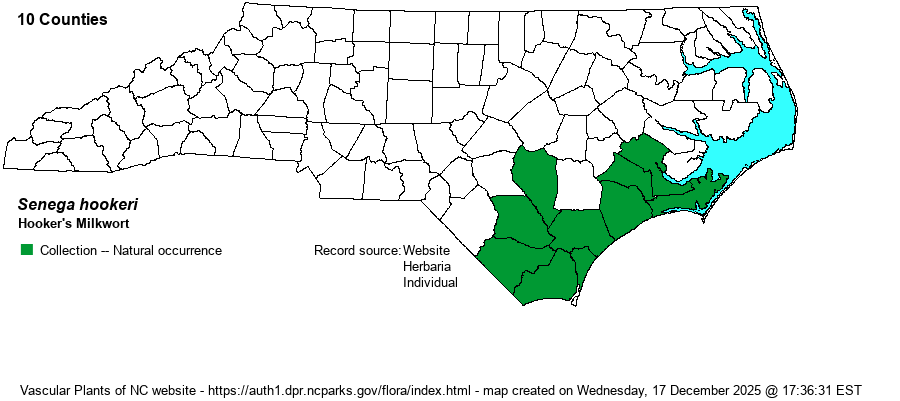| Author | (Torr. & A. Gray) J.F.B. Pastore & J.R. Abbott | |
| Distribution | Found only in the southeastern Coastal Plain, from Craven and Sampson counties southward -- mainly in the coastal Longleaf Pine (Pinus palustris) zone.
This is a scarce species ranging sporadically from southeastern NC to the FL Panhandle, and west to eastern LA.
| |
| Abundance | Rare to locally infrequent (in well-maintained savannas), found mainly in well-managed natural areas. This is a State Special Concern species. | |
| Habitat | This is a species that is essentially limited to pine savannas, found mostly where the habitat is burned every few years to keep savannas relatively free of competing woody vegetation. Unlike most other Senega species of Coastal Plain wetlands, this seldom occurs in ditches, scrapes, and other disturbed soil. |
| Phenology | Blooms from June to August, and fruits shortly after flowering. | |
| Identification | This is a slender species, growing only to about 8-10 inches tall, with a few branches in the upper portions. Like S. cruciata and S. brevifolia, this species also has a few sets of whorled stem leaves, 4 per whorl; however, in this species the leaves are quite short and only about 2/5-inch long. Also unlike those two, the flower clusters at the branch tips are elongated, about 1 inch long but barely 2/5-inch wide -- at least twice as tall as broad. The other two have clearly rounded flower clusters barely taller than broad. The flowers in S. hookeri are lavender to pink, about as in the other two species. S. nuttallii also has spire-like racemes of pink flowers, but that species has alternate stem leaves, not whorled as in S. hookeri. | |
| Taxonomic Comments | All of the former Polygala species in NC have now been moved to the genus Senega in 2023. | |
| Other Common Name(s) | None | |
| State Rank | S2S3 | |
| Global Rank | G3 | |
| State Status | SC-V | |
| US Status | | |
| USACE-agcp | | |
| USACE-emp | | |

